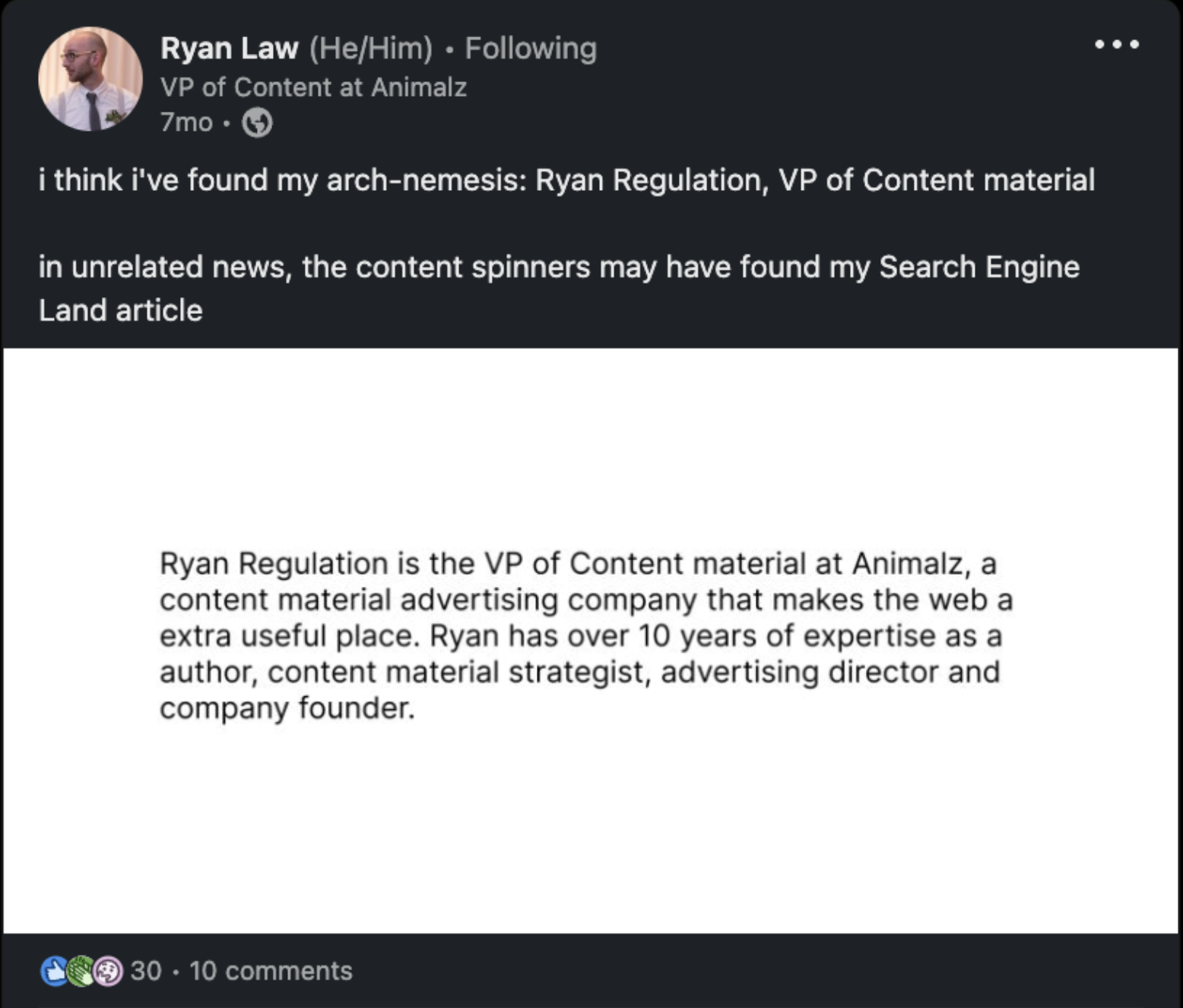Please Don’t Clearscope Me – I Want to Write Something New
Remember the first time you used content grading software?
I sure do.
I had just finished writing a blog post for a client, creatively slinging sentences together, imagining sucking my readers in, and pulling them from one line to the next. Having used their competitor’s product, I knew I could relate to their audience enough to write a compelling piece.
After reviewing and polishing the writing on my own, I was ready to send the first draft over. But in the brief the editor instructed me to first run the writing through Clearscope and get an A- rank before sending anything in.
Fair enough, I thought.
The Demise of my Original Work
C-
Damn. I guess it’s not quite ready.
All good, I’ll just add this keyword here, that one there, then add this sub-head here and include this keyword in it, and then this paragraph at the end should work.
B+
Hmmm, ok. How about I swap this word out and add this key phrase here?
A-
Great. Send!
The editor gets back to me with some minor edits. I make all the necessary changes and send the draft over again. A week later, the post is published, and I go to check it out.
Not even three lines into the intro, I see a word I know I didn’t put there. Then another… and another.
And then all I could think was, “who the hell wrote this?”
This supposedly written-by-me bylined article was no longer the unique, creative content piece I was proud to have written.
Instead, in front of me now was just another re-hashed post made to tick off keyword lists and word count goals. At this rate, it could have just as well been written by a robot.
And I’m not alone.
Freelance writer Amna Aslam shared with me in a DM conversation:
“I prefer my original work… I focus more on human-first content. Keywords are a seasoning. But when you use these tools, the main focus is to add specific keywords and headings. My clients only accept work if it's A+ for ClearScope and 70+ for SurferSEO. To achieve this score, I have to stuff keywords that sometimes I feel are unnecessary.”
But sadly, this is what the bulk of content ranking on search looks like today.
And we need to fix that.
Original Content is More Than Just Plagiarism-Free
Everyone claims they write original content.
Obviously, that can’t always be true. Some writers blatantly don’t and just plagiarize other people’s work, like what happened to Animalz’ VP of content, Ryan Law:
But there’s a lot more to crafting original content than simply avoiding plagiarism.
Think about the last piece you published. After running the draft through your content grader of choice and “sprucing” it up to include all possible keyword combinations, you probably thought you had a pretty good piece (just as your writer might have… before the draft got stuffed with keywords).
And Google probably thought the piece was good too and maybe even rewarded you with that beautiful ranking of page 1 of search results. Then, a potential customer might have searched their query, found your content, and gotten the answer to their question.
Another successful article – way to go!
Not quite.
While you might have answered a question, you haven’t done anything to make a lasting impression.
Although your offer is related to the search query (and probably very helpful to people looking it up), do you think that person will remember your brand the next time they seek answers to that same problem?
Especially given that after they finished reading your article, they realized it was the same as every other piece they had read on that topic?
No. They’re going to think (just as you or I do when we find unmemorable answers), “what did I search to answer this problem last time?”.
They won’t think any of the things you actually want them to, like:
“OMG, this is amazing. I need to bookmark this now!”
“This article gets me. I wonder what else this website has?”
“I need to keep this company in mind for when I’m willing to shell out real money to solve this problem.”
This is the problem with current search content.
Not only are these SEO-optimized articles polluting the SERPs with boring-ass content, but this approach is just a plagiarism-free way to copy someone else’s work. And on top of that it’s probably not producing the business results you’re hoping for.
Like Ryan Law (or Regulation, depending on where you find his work) wrote in his copycat content article:
“It might rank for a bunch of keywords, but what use is it if no-one remembers your brand, or becomes a customer?”
So how do you add authentic originality to your content?
Originality Should Come From SMEs – Not Writers
You need to go deeper than the minimum topical coverage your content grader tells you to include.
As Camden Gaspar, ex-MarketMuse employee, told us over chat:
“SEO has advanced in so many ways, but some people are still looking for “scores” and things to game instead of doing the hard work of creating good content.”
And to do that, you need to offer something unique. Something that only your company or an industry veteran would have insights into.
This is why you can’t hire a writer “with experience writing for [industry]” and expect them to write a thought-provoking piece as if they had “experience working in [industry].”
If they’ve been writing surface-level articles in a niche and getting A+ scores, then yes, they can write in that niche. But they’re still just re-writing what everyone else has already said.
Devesh Khanal, co-founder of Grow and Convert, writes about this in his article on outsourcing blog writing:
“[Companies] put the onus on the freelance writer to formulate the detailed arguments for the piece and find supporting information for those arguments… That should not be their responsibility, because they’re not the subject matter expert.”
It’s not the writer’s fault your content sucks.
When you give your writer a brief, a Clearscope report, and a deadline and then leave them to fend for themselves… you’re setting them up for failure.
Don’t set your writers up for failure by not giving them all the tools they need.
How can anyone create a killer piece of content with only those shallow resources?
You need to set your writer up with an SME or some internal experts. Get them in contact with someone who has real industry insights. Someone they can extract deep product knowledge or anecdotes from to create something truly memorable.
Most writers I know would be happy to interview someone who knows way more about the topic than they do. We want to write epic content for you – we just need access to epic source material.
And I can hear you now groaning as you read these words… “But this is an SEO play, not a thought leadership exercise.”
You Can Meet Search Intent and Provide a Unique Experience
Search content doesn’t have to be boring.
You can still use your tools and make an article worthy of page 1 rankings. But then you can go a step further and make something worth remembering, sharing, and linking to.
Google’s constantly evolving to reward quality content. Their intent is to provide the best user experience possible by serving up helpful content – something they’re now actively updating their algorithm to accomplish.
Some questions that Google uses to determine search rankings after their Helpful Content Update.
Our goal should be the same.
Let’s go back to your content piece from earlier. The one where your potential customer got their answer, bounced off-page, and then forgot all about you.
Imagine that throughout your article you sprinkled in some insider wisdom, a unique viewpoint, or proprietary data.
Imagine you gave them everything they asked for and something they didn’t. Something you knew would help them. Something that might even answer their next question before they realize what that might be.
Not only did you answer their immediate question, but you also left them with something to think about when they’re off-screen – something to remember you by.
Camden explains how this is possible in a Superpath article:
“SEO considerations dictate form considerably, and content to a lesser extent… We don’t need to just copy what other articles have done. We don’t need to combine the other top-ranking search results into one frankenstein of an article. We can provide value, have a distinct voice and point of view, and bend the knee to Google only as much as we need to to get results.”
That’s how you build trust.
That’s how you become memorable.
And that’s how you’re going to dominate search.
Be a Search Leader
I challenge you to up your search content game. By all means, use your tools, follow your checklists and do what you need to rank.
But don’t stop there. Give your writers something more to work into the content.
Then they can do their job and make your readers remember you.




